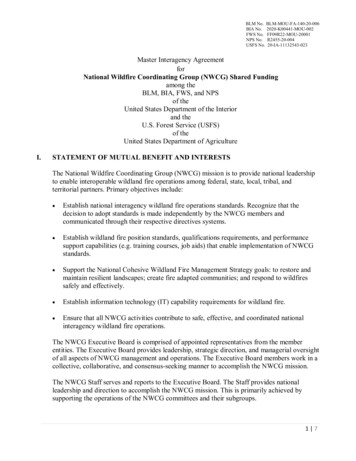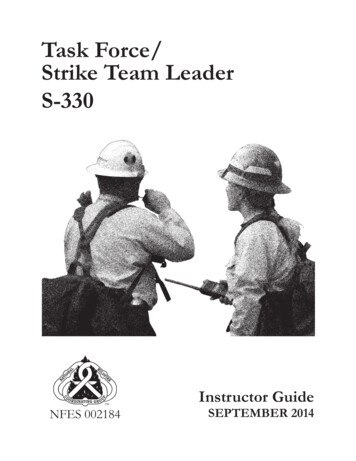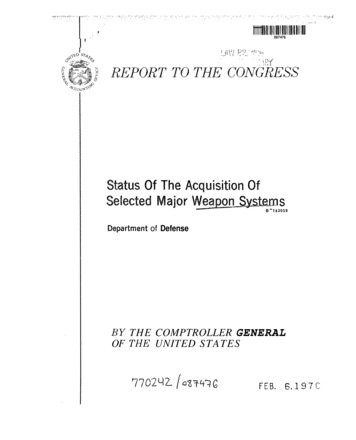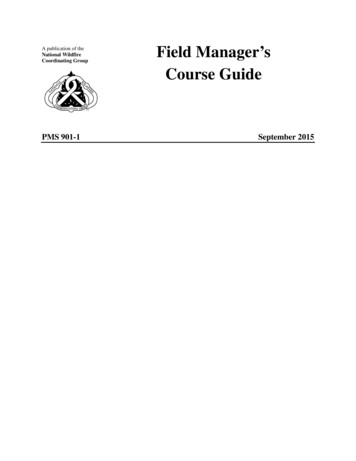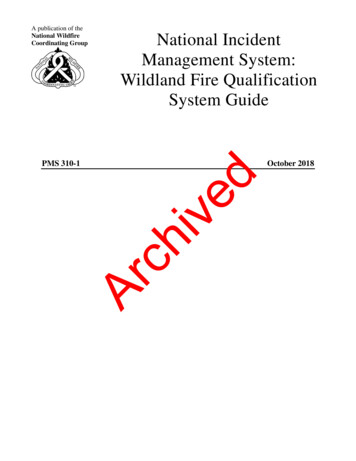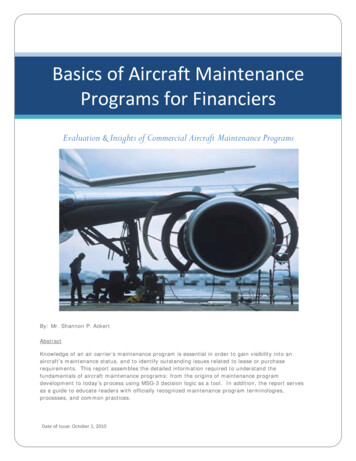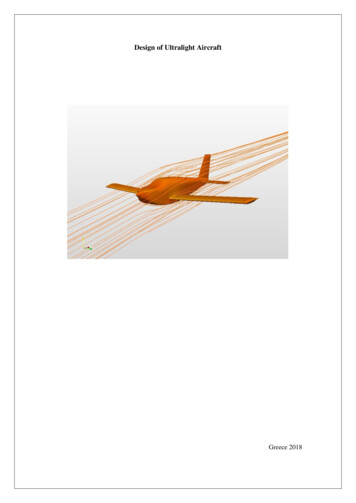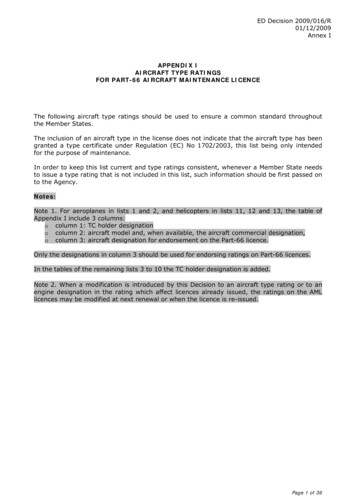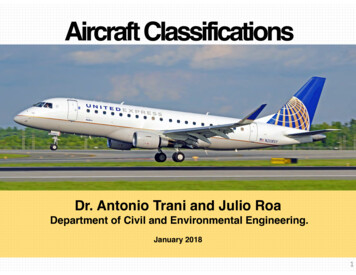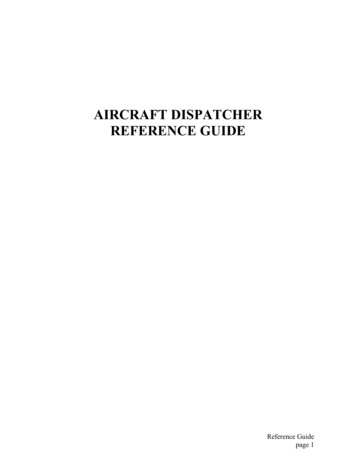
Transcription
AIRCRAFT DISPATCHERREFERENCE GUIDEReference Guidepage 1
Twelve Standard Aviation Questions That Shout“Watch Out”1.Is the flight necessary?2.Who is in charge?3.Are all hazards identified and have you made them known?4.Should you stop the operation on the flight due to change in conditions?a. Communicationsb. Weatherc. Confusiond. Turbulencee. Personnelf. Conflicting Priorities5.Is there a better way to do it?6.Are you driven by an overwhelming sense of urgency?7.Can you justify your action?8.Are there other aircraft in the area?9.Do you have an escape route?10.Are any rules being broken?11.Are communications getting tense?12.Are you deviating from the assigned operation of flight?Anyone can refuse or curtail a flight when an unsafe condition may exist. Never let unduepressure (expressed or implied) influence your judgment or decisions.Avoid Mistakes, Don’t HurryReference Guidepage 2
CONTENTSIntroduction .5Processing Aviation-Related Orders .6Aerial Supervision Requirements .7Required Tactical Aircraft Ordering Information .8Helicopter Ordering Sequence .9Followup, Demobilization, Closeout Checklist .10SAFECOM Submission Checklist .11Flight Planning Checklist.13TFR Request Checklist .15Frequency Management Checklist.16Portable Retardant Base Checklist .16Temporary Tower Checklist .17Supplemental Information Checklist .18Aircraft Make and Model Reference Information .19Phonetic Alphabet .22Time Conversion Chart .23Reference Section .24Forms .24Manuals .25Handbooks .26Reference Guidepage 3
Guides .27Plans/Other Publications .29Web Sites .30Required Cost Comparison Information .31Cost Comparison Formulas.32Aviation Contacts .34Reference Guidepage 4
INTRODUCTIONThis reference guide provides decision charts, checklists, direction, and points of contact toassist personnel in performing the responsibilities of the Aircraft Dispatcher.It is designed for personnel that need a quick reference for outlining non-routine procedures orwho are not assigned in the Aircraft Dispatcher role in their day-to-day job.Use this reference guide for assistance with order type determination, processing requirementsand procedures, dispatch routing channels, followup, and closeout of orders.Reference Guidepage 5
Processing Aviation-Related OrdersChoosing the Correct FormIF the missionrequest is.AND the followingresource is requested.AND it will be filledwith.AdministrativeTHEN, process the orderon.Flight Request/ScheduleAirtankerROSS Aircraft Resource OrderExclusive UseSEATCWNROSS Aircraft Resource OrderAND O/H Resource Order formanager and/or Supply/EquipmentR/O (for retardant & water tender)Air AttackLead PlaneROSS Aircraft Resource OrderExclusive UseHelicopterCWNROSS Aircraft Resource OrderAND O/H Resource Order formanager and crew membersLight fixed-wingROSS Aircraft Resource OrderSmokejumper Aircraft (a/cONLY)TacticalIA SmokejumperROSS Overhead Resource OrderInfraredROSS Aircraft Resource OrderAND Infrared Aircraft ScannerRequestTFREmergency Aircraft RadioFrequenciesROSS Aircraft Resource OrderTemporary FAA TowerExclusive UseAerial IgnitionCWNAir Attack Radio KitA/C Resource Order ANDO/H Resource Order (for Mgr.,module or PSD operator) ANDEquipment R/O (for helitorch orPSD) AND Supply R/O (forspheres or fuel)ROSS Equipment Resource OrderReference Guidepage 6
Aerial Supervision RequirementsSituationLead/ATCO/ASM1REFAirtanker not IA ratedMAFFSRetardant drops incongested areasLevel 2 SEAT operatingover an incident with morethan 1 other tacticalaircraft on sceneForeign GovernmentAirtankersRetardant drops conductedearlier than 30 minutesprior to sunrise, or laterthan 30 minutes aftersunset4 or more airtankersassigned2 or more helicopters with2 or more airtankers overan incidentPeriods of marginalweather, poor visibility orturbulence2 or more airtankers overan incidentWhen requested byairtanker or ATGSSmokejumper or Paracargoaircraft with 2 or moreairtankers over anincidentsIncident has 2 or morebranches.RequiredRequiredOrder111Required if No ATGS1Required if No ATGS1Required if No ATGS1,2OrderATGSMay use if NoLead/ATCO/ASM1Required if NoLead/ATCO/ASM1REF1Required if NoLead/ATCO/ASM1Required if der13Required1Required if noLead/ATCO/ASM1RequiredOrder if NO ATGS1Order if NoLead/ATCO/ASM11,4Order1,41,2Reference Information:1Interagency Lead Plane operations Guide and Interagency Air Tactical Group Supervisor Guide(NFES 1393).2Requires determination by ATGS or LEAD that visibility and safety factors are suitable anddispatch has been notified of the determination.3USFS FSM 5716.32.4Both the ILOG and ATGS Guide reference ordering and ATGS only for these missions.FSM 5716.32 classifies these missions as complies. An ATCO and/or HLCO should be orderedas appropriate in addition to the ATGS.Reference Guidepage 7
Reference Guidepage 8
Helicopter Ordering SequenceReference Guidepage 9
Followup, Demobilization, CloseoutChecklist Confirm release of tactical air resources with incident. Check with local dispatch center manager, neighbors, and GACC for possiblereassignment of resources prior to releasing to home unit. Dispatch center notification to GACC of Type I and Type II helicopters availablefor reassignment. Fax flight strip to GACC if leaving Geographical Area. GACC notification to the National Interagency Coordination Center of availabilityof Type I and Type II helicopters ready for reassignment/release. Relay ETAs of released aircraft through dispatch channels. Complete documentation and close out ROSS resource orders and/or aircraftrequest/schedule. Confirm flight following procedures for aircraft prior to release. Check regional mobilization guide for geographical procedures.Reference Guidepage 10
SAFECOM Submission ChecklistPURPOSE OF THE FORMS: To report any damage or injury less than "accident" criteria and any condition, act,observance, act, maintenance problem, or circumstance which has potential to cause anaviation related accident. To document all aviation hazards, incidents, incidents with potential, or accidents. To perform trend analyses for short- or long-term changes in policy and procedures, identifyareas needing training, etc. To establish accountability on the part of all aviation mission participants for meeting flightand employee safety objectives.APPLICABILITY:The form is to be completed for any one of five occurrences: Maintenance deficiency Aviation hazard Incident Incident with potential AccidentRESPONSIBILITY AND REQUIREMENTS FOR COMPLETION:Incident/Aviation Hazard/Maintenance Deficiency Report.It is the responsibility of any individual (including contractors) who observes or who isinvolved in an aviation incident/hazard/maintenance deficiency to report the occurrenceimmediately to local aviation management staff. Local Aviation Manager is responsiblefor reviewing the report and forwarding it through agency channels. Within two working days after an aircraft incident, aviation hazard, or maintenancedeficiency, the Local Aviation Manager or participant in the flight shall completeand submit Form OAS-34 Aircraft Incident/Aviation Hazard/MaintenanceDeficiency Report. The report shall be forwarded by express mail or fax to the State,Area, or Regional Aviation Manager within three working days after the occurrence. With the exception of incidents with serious potential, the State/Area/RegionalAviation Manager shall, within five working days after the occurrence of theincident/hazard, review, add comments as necessary, and forward the report to AMDand to the Bureau/Office Aviation Safety Manager. Serious incidents with potential to cause an accident (occurrences which meet"incident" criteria, and especially near mid-air collisions) shall be reportedimmediately.Reference Guidepage 11
Initial Report of Incident or Accident.The responsible employee shall document that facts and immediately file the report withhis/her supervisor. Regions shall immediately report by telephone all aviation accidentsor incidents with potential to the National Aviation Safety Officer.Each individual and each organization has an obligation to others in aviation to sharehazard, mishap and causal information. Each unit's aviation accident prevention planshould, therefore, contain provisions for encouraging the reporting of such informationby individuals. The information is documented and processed for system-widedistribution. Copies are routed to the Regional Aviation Safety Manager and Forest AviationOfficer as soon as possible. Accidents and incidents with potential are to be reportedimmediately.SAFECOM FORM LOCATION:Reference the Interagency Helicopter Operations Guide, Appendix C, Exhibit C-1.Electronic versions of the SAFECOM are online at www.safecom.gov.STATE AND LOCAL AGENCY REPORTS:Reference local formats. Federal personnel managing helibases or engaging in helicoptermissions for state or local agencies should complete the state or local format. If none exists,complete a SAFECOM OAS-34 (FS 5700-14) and submit to the local unit AviationManager.Reference Guidepage 12
Flight Planning ChecklistA. Required Information1. Passenger names/body and baggage weights*2. Date/time of requested flight*3. Flight route/itinerary*a. Aircraft needed to standby/R.O.N.4. Pick up/drop off location for passengers (FBO)*5. Establish a Chief of party/flight manager for flight*6. Cargo: type/weight/volume/any hazardous materials*a. Will cargo fit through aircraft door?7. Cost comparison done.a. Determine alternate means of traveli. Commercial airlinerii. Government owned aircraftB. Environmental Factors1. Day or night flighta. Night requires twin engine IFR aircraft for passengers.b. Single engine aircraft for cargo OK at night with pilot discretion.2. Weather Conditionsa. Thunderstormsb. High temperaturesc. Windsd. Know ice conditionse. Visibility (fog/dust/smoke)3. Terraina. High elevationb. Mountains4. Density Altitudea. High temperatures and elevation; aircraft will need 25% more runway for takeoff.b. Number of passengers and amount of cargo an aircraft can transport is reduced.C. Airport Factors1. Runway length adequate2. Runway gravel vs. hard surfacea. Can aircraft operate on gravel?3. Runway load bearing weighta. Is aircraft too heavy for airport?4. Elevation5. Runway lights (YES or NO)6. IFR approach7. Fueling facilitiesa. Type of fuel available (Avgas/Jet)8. Noise restrictionsReference Guidepage 13
D. Aircraft Criteria1. Approved*2. Number of insured seats3. Payload4. Multi or single engine5. IFR vs. VFR6. De-icing equipment7. Speed8. Fuel type & consumption9. High wing or low wing10. Any avionics requirementE. Pilot Criteria1. Approved for specific flight.*a. IFR/multi engine qualified?2. Duty day limitation (14 hours)a. When did duty day start?3. Flight hour limitationsa. 8 hour flight time for single pilotb. 10 hours flight time for dual pilotsF.NIFC Large Transport Requirements1. NICC responsible for all flight planning.2. Notify local airport manager of jet’s arrival.3. Notify local fire department (if required).4. Notify crew desk/supv. dispatcher/ramp manager.5. APU available6. Stairs availableG. Dispatcher Responsibilities1. Relay flight information to vendor, pilot, ramp manager, and overhead desk.2. Determines means of flight following.3. Relays flight following information to GACC, sending & receiving units.4. Briefs flight manager.H. Flight Manager Responsibilities1. Ensures that all passengers are at initial departure location.2. Briefs pilot and passengers on flight.3. Informs dispatch of any changes in passengers or flight route.4. Verifies that aircraft and pilot are agency’s approved.5. Ensures that passengers receive a safety briefing from pilot.6. Ensures pilot complies with flight following procedures.7. Verifies flight invoice entries.8. Completes and submits SAFECOM for any flight irregularities.Reference Guidepage 14
Temporary Flight Restriction (TFR) RequestChecklistDocument all actions pertaining to TFRs. Check your local Geographical Area procedures forprocessing. "A" number to Geographical Area Coordination Center (GACC) Request TFR from Air Route Traffic Control Center (ARTCC) Provide the following information: Estimated duration of operations Brief description of incident/hazard/or nature of airborne relief VOR, DME, Latitude, Longitude Horizontal restriction (standard is 5 nautical miles from incident or project center point) Vertical restriction (2,000 ft. above either the highest elevation or air operations base) Contact point Request call back from ARTCC with confirmation that TFR is in place. Request advisory NOTAM from local FSS for both disaster and non-disaster air operations. Relay TFR information and status to unit dispatch, GACC, incident commander, andresponding air resources. Consult with incident commander, air operations branch director or project manager onwhether TFR dimensions are adequate. Modify TFR dimension as necessary. Cancel TFR with ARTCC when it is no longer needed. Dissemination (Map and NOTAM): Airtanker Bases Helibases Fixed Base Operators Military Schedulers GACCReference Guidepage 15
Frequency Management Checklist Order additional temporary emergency radio frequencies through the GACC to NICC. Use Area assigned VHF-AM frequencies. Air Tanker Base Ramp Frequency: 123.975 MHz National flight following frequency: 168.650 MHz Frequency for the tracking of national share resources (air tankers, lead planes,helicopters) between Geographic Areas. Frequency is not for local flight following. National Air Guard frequency: 168.625 MHz Frequency is for emergency communication only.¾Air to Air emergency contact and coordination.¾Ground to Air emergency contact.¾Initial call, recall, and re-direction of aircraft when no other contact frequency isavailable.Portable Retardant Base Checklist Determine suitable base Adequate water source Air Tanker or Helicopter Operations Coordinate base operation with airport manager Additional personnel Housing/meals/transportation Support equipment Consider private vendors that are available and self-supporting Assign agency liaison for safety, efficiency, cost effectiveness and contract assistance Lead time for set up of operationReference Guidepage 16
Temporary Tower Checklist Temporary tower should be activated when: Operation being conducted from or in the proximity to an uncontrolled airport. High volume of aircraft anticipated in close proximity to each other. High frequency of non incident aircraft using common airspace. Visibility is limited at an uncontrolled airport. Request for a temporary tower is done on aircraft resource order through normal dispatchchannels. Tower consists of 2 FAA controllers (no actual tower). See Interagency Air Space Coordination Guide for more details. Check with incident/project whether relief controllers will be required. Discuss with incident/project the required support for the temporary tower. Radio (VHF base station) Anemometer Wind sock Altimeter Thermometer Compass Shelter with a view of the entire airport ¾ Trailer¾ Electric¾ TelephoneLodging & Meals Notify Regional Airspace Coordinator of Temporary Tower request. Ensure that temporary tower information is disseminated to all appropriate units. FAA NOTAM Consult with Airport Manager. Ensure Unit Aviation Officer briefs FAA controller on their arrival.Reference Guidepage 17
Supplemental Information ChecklistIF the order is for.Relief planning forLead/ATCO/ASM/ATGSTHEN determine if the following isneeded.Consider duration of incident.Pilot flight hour and duty day limitations.Aircraft refueling.Rest break for pilot.InfraredIR InterpreterIR RequestAerial IgnitionManager/module/operatorFiring equipmentFuelSEATManagerRetardantWater Source/TenderDetectionRadio Kit - with VHF-FM capabilityQualified ObserverReference Guidepage 18
Aircraft Make and Model Reference InformationAir Tanker Information:Make/ModelC-130 Wing Span(feet)CruiseSpeed(kts/mph)ContractOperating 6142Reference Guidepage 19
Helicopter seSize /18580/92Number ofPax SeatsTYPE IKaman H-43Bell 214 B-1Blackhawk UH-60Sikorsky S-61NBoeing Vertrol 107Boeing 234(CH-47)Sikorsky S-64 Skycrane2562657383998947525462506072TYPE IIBell 204B/UH-1BBell Super 204Bell 205 A-1Bell 212Bell 412Sikorsky TYPE IIIMD-500D (Hughes)Bell 206 BIII Jet RangerBell 206 L-3 Long RangerAS-350 D-1 AstarAS-350 B-2 EcureuilAS-355 F-1 Twin StarSA-315 B LamaSA-316B Alouette AN/A46N/AReference Guidepage 20
Fixed Wing Information:Make/ModelLength(feet)Single EngineCessna 172Cessna 180Cessna 182Cessna 182RGCessna 185Cessna 205Cessna 206Cessna 210Cessna 210(Turbo)Piper PA-18 SupercubPiper PA-32R LanceBeech BonanzaDHC-2 Beaver (Floats)27262828262828282823282630Twin EngineCessna 337 SkymasterCessna 340Cessna 414Cessna 421Golden EagleCessna 441Conquest I/IIPiper PA-23 AztecPiper PA-34 SenecaPiper PA-42 Cheyenne IIPiper PA-42 Cheyenne IIIBeechcraft Baron 55Beechcraft Baron58/PBeechcraft King Air 100Beechcraft King Air 200Aero Commander 500Aero Commander 690Aero Commander 840Partenavia P-63Islander BN-2DC- 3 TurboSherpas S-330(C-23)DHC-6 Twin OtterCasa 001009007001400Numberof 9199Req. 00025001800Reference Guidepage 21
Phonetic AlphabetCharacterTelephonyPhonic AR-LEE OR H)(SEE-AIR-RAH)(TANG-GO)(YOU-NEE-FORM OR EN)(AIT)(NIN-ER)(ZEE-RO)Reference Guidepage 22
Conversion from USA Time Zones to UTC (ZULU)ALASKA DAYLIGHT 8HAWAIIAN STANDARD 10EST Eastern Standard TimeCDT Central Daylight TimeUTC ST CDT 57 PM8 PM9 PM10 PM11 PMMIDNIGHT1 AM2 AM3 AM4 AM5 AM6 AM7 AM8 AM9 AM10 AM11 AMNOON1 PM2 PM3 PM4 PM5 PM6 PMMST PDT PST MDT CST MDT 66 PM7 PM8 PM9 PM10 PM11 PMMIDNIGHT1 AM2 AM3 AM4 AM5 AM6 AM7 AM8 AM9 AM10 AM11 AMNOON1 PM2 PM3 PM4 PM5 PMMountain Standard TimePacific Daylight TimePacific Standard TimeMountain Daylight TimeMST PDT 75 PM6 PM7 PM8 PM9 PM10 PM11 PMMIDNIGHT1 AM2 AM3 AM4 AM5 AM6 AM7 AM8 AM9 AM10 AM11 AMNOON1 PM2 PM3 PM4 PMPST 84 PM5 PM6 PM7 PM8 PM9 PM10 PM11 PMMIDNIGHT1 AM2 AM3 AM4 AM5 AM6 AM7 AM8 AM9 AM10 AM11 AMNOON1 PM2 PM3 PMReference Guidepage 23
Reference Section:FormsFlight Schedule/RequestFormFlight StripsSAFECOMsPassenger and CargoManifestAircraft Dispatch FormOAS-110 Travel CostAnalysisFS-5700-10Flight Justification FormFS-5700-11Forest Service CostComparison FormFS-5700-12Day Trip AuthorizationFormSenior Travel Form GSA3641TFR Request FormPurposeForm provides flight request andmanifest information, flightfollowing documentation, andchecklists for point to point andspecial use flights.Form used for flight following.Form used for documentingunsafe aviation practices.Form used to documentindividuals’ names, weights,home units and cargo weight.Form used by helicoptermanager and pilot with incidentinformation.DOI Cost analysis and flightapproval formForest Service flight approvalformForest Service cost analysis formSourceLocal Dispatch OfficeNational Mobilization Guidehttp://www.nifc.gov/nicc/mobguide/chapter 20.pdfForm is used to approve anddocument non Federalpassengers and contractors onForest Service controlledaircraft.Form is used to report the travelsof SES, non Federal passengers,and contractors on governmentcontrolled aircraft and use.Form used to request aTemporary Flight orary Tower RequestFormForm used to request a FAATemporary Tower.Smokejumper InitialAttack RequestTactical Aircraft FormResource order used to requestsmokejumper.Form used by ATGS todocument aircraft responding toor on an incident.Local Dispatch Officehttp://www.safecom.gov(NFES 1289)(NFES ovNational Mobilization Guidehttp://www.nifc.gov/nicc/mobguide/chapter 20.pdfNational Mobilization Guidehttp://www.nifc.gov/nicc/mobguide/chapter 20.pdfLocal Dispatch Office-ROSSLocal DispatchReference Guidepage 24
FormsTactical Fix-WingInformation SheetInfrared Aircraft ScannerFormPurposeForm used to obtain transittactical aircraft and vendorinformationForm used to request an infraredflight for an incident.Orange CardManualsDepartmental DOI 350-354DMFSM 5700 AviationManagementBIA Indian affairs ManualPart 57BLM 9400 OperationalProceduresFWS Manual 330-339 –Aviation ManagementNPS RM-60 Aviation USForest Service ManagementReference ManualState Aviation14 CFR Federal AviationRegulations (FARs)Aeronautical InformationManual (AIM)Interagency Standards forFire and Fire AviationOperations (Redbook)Wildland Fire and AviationOperations guide(Bluebook)AgencyDepartment of the InteriorBureausUS Forest ServiceSourceNational Mobilization Guidehttp://www.nifc.gov/nicc/mobguide/chapter 20.pdfNFES 1399Sourcehttp://amd.nbc.govBureau of Land ion.blm.govUS Fish and Wildlife Servicewww.fws.gov/fireNational Park Servicewww.nps.gov/nifc/StateFederal AviationAdministrationState Fire ifc.gov/red book/Bureau of Indian AffairsRegional BIA Fire OperationBureau of Indian AffairsReference Guidepage 25
HandbooksUSFS Handbook 5709.16AgencyUS Forest ServiceAviation Life SupportEquipment HandbookInteragency AviationTransport of HazardousMaterials HandbookDepartment of the InteriorBureausInteragencyFireline Handbook –NWCG Handbook 3InteragencyFSH 5709.11 Fixed WingHandbookFSH 5709.14 SmokejumperOperations HandbookFSH 5709.16 In-ServiceFlight OperationsFSH 6309.11 ContractAdministration HandbookFSH 6709.12 Health andSafety Code HandbookHeliport InstallationHandbookMilitary HandbookUS Forest ServiceAerial Capture Eradicationand Tagging of AnimalHandbookAviation Fuel HandlingHandbookAviation Life SupportEquipment (ALSE)HandbookHelicopter Short-HaulHandbookDOD AP/1A & 1BHandbook & ChartsBLM Wild Horse and BurroAviation HandbookUS Forest ServiceUS Forest ServiceUS Forest ServiceUS Forest ServiceBureau of Land ManagementInteragencyDepartment of the ationhttp://amd.nbc.gov(NFES 1068) National FireEquipment System CatalogPart 2 Publicationshttp://amd.nbc.gov(NFES 0065) National FireEquipment System CatalogPart 2 nhttp://aviation.blm.govNFES partment of the InteriorBureausDepartment of the InteriorBureaushttp://amd.nbc.govDepartment of the InteriorBureaushttp://amd.nbc.govDepartment of DefenseBureau of Land Managementhttp://amd.nbc.govNIMA 800-455-0899NOAA 800-0638-8972 X-129http://aviation.blm.govReference Guidepage 26
GuidesAir Tactical GroupSupervisor GuideAgencyInteragencyInteragency Aviation MishapResponse Guide andChecklistIncident Response GuideInteragencyInteragencyField Reference Guide forAviation UsersInteragency SmokejumperPilots Operation GuideNational MobilizationGuidesDepartment of the zation GuidesInteragency Air Tanker BaseOperations GuideInteragencyInteragency AirspaceCoordination GuideInteragency Airtanker BaseDirectoryInteragencyInteragency HelicopterOperations GuideInteragencyInteragency Rappel GuideInteragency Single EngineAir Tanker Ops. GuideInteragencyInteragencyRegional Frequency GuideInteragencyAircraft Identification ource(NFES 1393) National FireEquipment System CatalogPart 2 Publicationshttp://amd.nbc.gov(NFES 1077) National FireEquipment System CatalogPart 2 ttp://amd.nbc.govhttp://www.nifc.gov/nicc/(NFES 2091) National FireEquipment System CatalogPart 2 PublicationsGACC and Local DispatchOffice Web pages(NFES 2271) National FireEquipment System CatalogPart 2 Publicationshttp://amd.nbc.gov(NFES 2537) National FireEquipment System CatalogPart 2 Publications(NFES 1885) National FireEquipment System CatalogPart 2 Publicationshttp://amd.nbc.gov(NFES 1844) National FireEquipment System CatalogPart 2 PublicationsRegional AviationManager/Officer(NFES 2393) National FireEquipment System CatalogPart 2 PublicationsReference Guidepage 27
GuidesInteragency AviationTechnical AssistanceDirectoryAgencyInteragencyInteragency Aviation UserPocket GuideInteragencyInteragency Retardant BasePlanning Guide (Fixed &Rotor Wing)Interagency Aerial IgnitionGuideInteragencyInteragency AviationTraining GuideThe Professional HelicopterPilotInteragencyBasic Aviation SafetyStudent GuideInteragency2004 Emergency ResponseGuidebookInteragency Call-WhenNeeded HelicoptersUS Department ource(NFES 1393) National FireEquipment System CatalogPart 2 Publicationshttp://amd.nbc.gov(NFES 1373) National FireEquipment System CatalogPart 2 Publicationshttp://amd.nbc.gov(NFES 1259) National FireEquipment System CatalogPart 2 Publications(NFES 1080) National FireEquipment System CatalogPart 2 Public
ROSS Aircraft Resource Order AND O/H Resource Order for manager and crew members Light fixed-wing ROSS Aircraft Resource Order Smokejumper Aircraft (a/c ONLY) IA Smokejumper ROSS Overhead Resource Order . The report shall be forwarded by express mail or fax to the State, Area, or Regional Aviation Manager within three working days after the .
